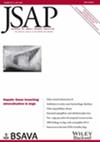Total hip arthroplasty for femoral fractures other than capital physeal fractures in dogs: 14 cases (2012-2020)
Abstract
Objectives
The goals of this retrospective study were to assess the clinical and radiographic outcomes in dogs with proximal femoral fractures, other than capital physeal fractures, treated via total hip arthroplasty.
Materials and Methods
Medical records as well as pre-operative, immediate post-operative and 2 to 3 months post-operative radiographs of 14 dogs with femoral head and neck fractures treated via total hip arthroplasty were reviewed. A Liverpool Osteoarthritis in Dogs questionnaire was completed by owners to assess long-term outcomes.
Results
Seven femoral head fractures, and seven femoral neck fractures were included. Four of the femoral head fractures were acute in nature, the three remaining femoral head fractures and all seven femoral neck fracture cases were chronic fractures. Malorientation of the femoral stem was more common in the chronic femoral fracture cases when compared to the acute femoral fracture cases. Two of the acute fracture cases and five chronic fracture cases experienced a change in femoral stem position post-operatively. One femoral fissure fracture occurred and was repaired intraoperatively. One case had a post-operative complication that resulted in implant removal. All dogs had good to excellent owner-perceived outcome.
Clinical Significance
Femoral head and neck fractures, and in particular the chronic cases, represented a challenging subset of cases presenting for total hip arthroplasty, resulting in suboptimal stem alignment in many cases. However, clinical outcomes were considered good to excellent in all dogs in the study, indicating that total hip arthroplasty is a viable treatment option for these types of fractures.

 求助内容:
求助内容: 应助结果提醒方式:
应助结果提醒方式:


